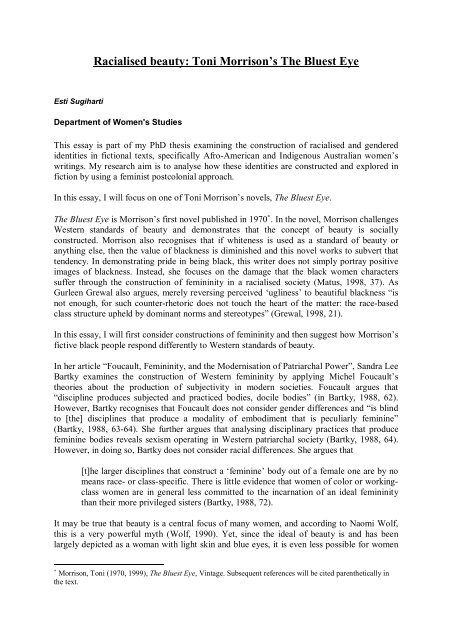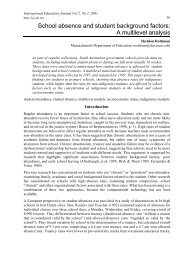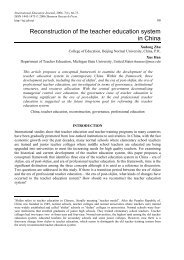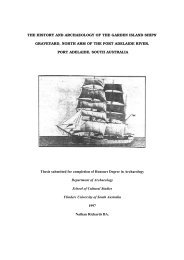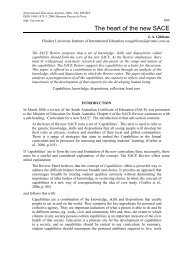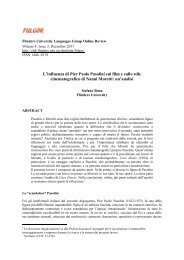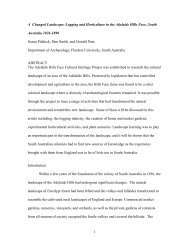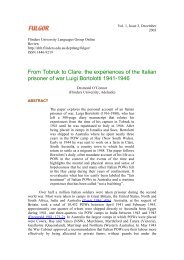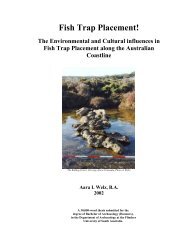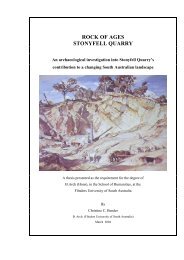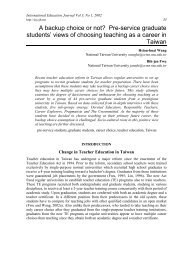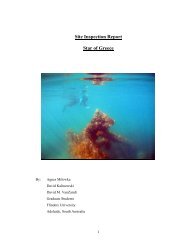Racialised beauty: Toni Morrison's The Bluest Eye
Racialised beauty: Toni Morrison's The Bluest Eye
Racialised beauty: Toni Morrison's The Bluest Eye
Create successful ePaper yourself
Turn your PDF publications into a flip-book with our unique Google optimized e-Paper software.
Esti Sugiharti<br />
<strong>Racialised</strong> <strong>beauty</strong>: <strong>Toni</strong> Morrison’s <strong>The</strong> <strong>Bluest</strong> <strong>Eye</strong><br />
Department of Women's Studies<br />
This essay is part of my PhD thesis examining the construction of racialised and gendered<br />
identities in fictional texts, specifically Afro-American and Indigenous Australian women’s<br />
writings. My research aim is to analyse how these identities are constructed and explored in<br />
fiction by using a feminist postcolonial approach.<br />
In this essay, I will focus on one of <strong>Toni</strong> Morrison’s novels, <strong>The</strong> <strong>Bluest</strong> <strong>Eye</strong>.<br />
<strong>The</strong> <strong>Bluest</strong> <strong>Eye</strong> is Morrison’s first novel published in 1970 ∗ . In the novel, Morrison challenges<br />
Western standards of <strong>beauty</strong> and demonstrates that the concept of <strong>beauty</strong> is socially<br />
constructed. Morrison also recognises that if whiteness is used as a standard of <strong>beauty</strong> or<br />
anything else, then the value of blackness is diminished and this novel works to subvert that<br />
tendency. In demonstrating pride in being black, this writer does not simply portray positive<br />
images of blackness. Instead, she focuses on the damage that the black women characters<br />
suffer through the construction of femininity in a racialised society (Matus, 1998, 37). As<br />
Gurleen Grewal also argues, merely reversing perceived ‘ugliness’ to beautiful blackness “is<br />
not enough, for such counter-rhetoric does not touch the heart of the matter: the race-based<br />
class structure upheld by dominant norms and stereotypes” (Grewal, 1998, 21).<br />
In this essay, I will first consider constructions of femininity and then suggest how Morrison’s<br />
fictive black people respond differently to Western standards of <strong>beauty</strong>.<br />
In her article “Foucault, Femininity, and the Modernisation of Patriarchal Power”, Sandra Lee<br />
Bartky examines the construction of Western femininity by applying Michel Foucault’s<br />
theories about the production of subjectivity in modern societies. Foucault argues that<br />
“discipline produces subjected and practiced bodies, docile bodies” (in Bartky, 1988, 62).<br />
However, Bartky recognises that Foucault does not consider gender differences and “is blind<br />
to [the] disciplines that produce a modality of embodiment that is peculiarly feminine”<br />
(Bartky, 1988, 63-64). She further argues that analysing disciplinary practices that produce<br />
feminine bodies reveals sexism operating in Western patriarchal society (Bartky, 1988, 64).<br />
However, in doing so, Bartky does not consider racial differences. She argues that<br />
[t]he larger disciplines that construct a ‘feminine’ body out of a female one are by no<br />
means race- or class-specific. <strong>The</strong>re is little evidence that women of color or workingclass<br />
women are in general less committed to the incarnation of an ideal femininity<br />
than their more privileged sisters (Bartky, 1988, 72).<br />
It may be true that <strong>beauty</strong> is a central focus of many women, and according to Naomi Wolf,<br />
this is a very powerful myth (Wolf, 1990). Yet, since the ideal of <strong>beauty</strong> is and has been<br />
largely depicted as a woman with light skin and blue eyes, it is even less possible for women<br />
∗ Morrison, <strong>Toni</strong> (1970, 1999), <strong>The</strong> <strong>Bluest</strong> <strong>Eye</strong>, Vintage. Subsequent references will be cited parenthetically in<br />
the text.
of colour than for white women to achieve this ideal. As Paul C. Taylor argues, “a whitedominated<br />
culture has racialised <strong>beauty</strong>, [in] that it has defined <strong>beauty</strong> per se in terms of<br />
white <strong>beauty</strong>, in terms of the physical features that the people we consider white [people] are<br />
more likely to have” (Taylor, 1999, 17, emphasis in original). <strong>The</strong>refore, in the process of<br />
trying to achieve <strong>beauty</strong>, as Taylor further argues, “the experience of a black woman …<br />
differs from the experiences of … Jewish and Irish women” (Taylor, 1999, 20). This can<br />
clearly be seen in the ways that the black women characters in Morrison’s novel suffer in<br />
trying to conform to Western standards of <strong>beauty</strong>.<br />
<strong>The</strong> <strong>Bluest</strong> <strong>Eye</strong> tells the story of an eleven year old black girl, Pecola Breedlove, who wants to<br />
have blue eyes, because she sees herself, and is regarded by most of the characters in the<br />
novel, as ugly. <strong>The</strong> standard of <strong>beauty</strong> that her peers subscribe to is represented by the white<br />
child actress, Shirley Temple, who has the desired blue eyes. <strong>The</strong> novel starts with the<br />
description of an ideal white family but in the near-parodic style of a school reading primer,<br />
where we meet Dick and Jane and their lovely parents living in a nice and comfortable house<br />
with a lovely dog and a cat. <strong>The</strong> Dick and Jane text functions as “the hegemonizing force of<br />
an ideology ([focused by] the supremacy of ‘the bluest eye’) by which a dominant culture<br />
reproduces [its] hierarchical power structure[s]” (Grewal, 1998, 24). As Donald B. Gibson<br />
also argues, the Dick and Jane text implies one of the primary and most insidious ways that<br />
the dominant culture exercises its hegemony, through the educational system. It reveals the<br />
role of education in both oppressing the victim – and more to the point – teaching the victim<br />
how to oppress her own black self by internalising the values that dictate standards of <strong>beauty</strong><br />
(Gibson, 1989, 20).<br />
In contrast to this hegemonic identity, the main black characters are depicted as various and<br />
very different characters located in three hierarchical families: “first Geraldine’s (a counterfeit<br />
of the idealised white family), … [then] the MacTeers and at the bottom [of the social order],<br />
the Breedloves” (Ogunyemi, 1977, 113). <strong>The</strong> novel shows how these black characters respond<br />
to the dominant culture differently and this refutes easy binary social distinctions.<br />
Pauline Breedlove, Geraldine, Maureen Peal, and Pecola are black characters who try to<br />
conform to an imposed ideal of femininity. <strong>The</strong>y are absorbed and marginalised by the<br />
“cultural icons portraying physical <strong>beauty</strong>: movies, billboards, magazines, books, newspapers,<br />
window signs, dolls, and drinking cups” (Gibson, 1989, 20). Pauline Breedlove, for example,<br />
learns about physical <strong>beauty</strong> from the movies. In Morrison’s words,<br />
[a]long with the idea of romantic love, she was introduced to another – physical<br />
<strong>beauty</strong>. Probably the most destructive ideas in the history of human thought. Both<br />
originated in envy, thrived in insecurity, and ended in disillusion (Morrison, 1970,<br />
1999, 95).<br />
Consequently, in trying to conform to the ideal of white femininity, the black women<br />
characters despise their blackness which in turn leads to self hatred. <strong>The</strong>y see themselves<br />
through the eyes of white people and their worship of white <strong>beauty</strong> also has destructive<br />
effects on their own community. This is because, as Taylor argues:<br />
[o]ne of the cornerstones of the modern West has been the hierarchical valuation of<br />
human types along racial lines. … <strong>The</strong> most prominent type of racialised ranking<br />
represents blackness as a condition to be despised, and most tokens of this type extend<br />
this attitude to cover the physical features that are central to the description of black<br />
identity (Taylor, 1999, 16).
Geraldine, for example, represses her black characteristics which are not ‘fitted’ to white<br />
femininity as she strives “to get rid of the funkiness” (Morrison, 1970, 1999, 64). She also<br />
rejects Pecola when she sees her in her house as Pecola seems to embody all the negative<br />
aspects of her views of black girls (see also Bouson, 2000, 37-38):<br />
She looked at Pecola. Saw the dirty torn dress, the plaits sticking out on her head, hair<br />
matted where the plaits had come undone, the muddy shoes with the wad of gum<br />
peeping out from between the cheap soles, the soiled socks, one of which had been<br />
walked down into the heel on the shoe. … She had seen this little girl all of her life.<br />
Hanging out of windows over saloons in Mobile, crawling over the porches of shotgun<br />
houses on the edges of town, sitting in bus stations holding paper bags and crying to<br />
mothers who kept saying ‘Shet up!’ (Morrison, 1970, 1999, 71-72).<br />
Being well educated and having adopted Western ways of life, Geraldine draws the line<br />
between coloured and black. She deliberately teaches her son the differences between<br />
coloured and black: “Coloured people were neat and quiet; niggers were dirty and loud”<br />
(Morrison, 1970, 1999, 67, also in Bouson, 2000, 37). Maureen Peal, a light-skinned girl at<br />
school, also thinks that she is pretty and Pecola is ugly and Morrison sets up a hierarchy of<br />
skin tone marking proximity and distance in relation to idealised physical attributes. As “[a]<br />
high-yellow dream child with long brown hair braided into two lynch ropes that hung down<br />
her back” (Morrison, 1970, 1999, 47), Maureen is treated well at school:<br />
She enchanted the entire school. When teachers called on her, they smiled<br />
encouragingly. Black boys didn’t trip her in the halls; white boys didn’t stone her,<br />
white girls didn’t suck their teeth when she was assigned to be their work partners;<br />
black girls stepped aside when she wanted to use the sink in the girls’ toilets, and their<br />
eyes genuflected under sliding lids (Morrison, 1970, 1999, 47-48).<br />
Finally, having been treated very badly by most people surrounding her, Pecola yearns to<br />
have blue eyes in the hope that people will love her.<br />
Despite those radical distinctions, the construction of femininity for black women is<br />
somewhat similar to that of white women in terms of gendered body and subjected body. For<br />
example, Pecola sees herself as ugly, as an object possessing an abject body. This is<br />
paralleled with what Bartky says about the process of disciplining practices to gain the ideal<br />
body of femininity which produces “a ‘practiced and subjected’ body, that is a body on which<br />
an inferior status has been inscribed. A woman’s face must be made up, that is to say, made<br />
over, and so must her body”(Bartky, 1988, 71). This suggests, as Bartky further argues, that<br />
“[women’s] bodies are deficient” (Bartky, 1988, 71).<br />
However, as Pecola does not have blue eyes, these social symbols of white <strong>beauty</strong>, she cannot<br />
come anywhere near to the ideal of white <strong>beauty</strong>. In other words, white women may lack<br />
something in terms of the gendered body, but due to their white privilege, they are not<br />
racialised in the same way. Grewal also argues that<br />
[I]f Irigaray’s feminine subject (a universal feminine subject) is defined as lack, as<br />
absence, then the black woman is doubly lacking, for she must simulate or feign her<br />
femininity as she dissimulates or conceals her blackness” (Grewal, 1998, 26).
<strong>The</strong>refore, <strong>The</strong> <strong>Bluest</strong> <strong>Eye</strong> can also be read as text which is critical of liberal white feminism<br />
which excludes the experience of black women. As Madhu Dubey also argues,<br />
[t]he presence that defines black feminine characters in the novel as deficient is<br />
represented not by the black man but the white woman. … Each expression of black<br />
feminine desire, whether Pecola’s longing for blue eyes, Frieda’s love of Shirley<br />
Temple, Claudia’s hatred of white dolls, Maureen’s adoration of Betty Grable, or<br />
Pauline’s of Jean Harlow, takes the white woman as its object (Dubey, 1994, 39-40).<br />
However, not all the black characters adore or are in awe of Western standards of <strong>beauty</strong>. <strong>The</strong><br />
novel also shows black people who are aware of the danger of adopting Western standards of<br />
<strong>beauty</strong>. Claudia, the young girl narrator, at the very beginning of the novel, describes herself<br />
as indifferent to both white dolls and Shirley Temple. She also realises that she does not really<br />
hate light-skinned Maureen but hates the thing that makes Maureen beautiful: “[a]nd all the<br />
time we knew that Maureen Peal was not worthy of such intense hatred. <strong>The</strong> Thing to fear<br />
was the Thing that made her beautiful, and not us” (Morrison, 1970, 1999, 58, emphasis in<br />
original). It is the ideology of whiteness that makes Maureen appear beautiful (Munafo, 1995,<br />
8) and as Bouson argues,<br />
the ‘Thing’ Claudia learns to fear is the white standard of <strong>beauty</strong> that members of the<br />
African American community have internalised, a standard that favours the ‘highyellow’<br />
Maureen Peal and denigrades the ‘black and ugly’ Pecola Breedlove (Bouson,<br />
2000, 31).<br />
As children, Claudia and her sister Frieda are happy with their difference, their blackness:<br />
“We felt comfortable in our skins, enjoyed the news that our senses released to us, admired<br />
our dirt, cultivated our scars, and could not comprehend this unworthiness” (Morrison, 1970,<br />
1999, 57). This may suggest that Claudia resists the pressure to conform to a white vision of<br />
<strong>beauty</strong>.<br />
However, as a child, Claudia wonders why people treat Maureen well because she is<br />
beautiful:<br />
Dolls we could destroy, but we could not destroy the honey voices of parents and<br />
aunts, the obedience in the eyes of our peers, the slippery light in the eyes of our<br />
teachers when they encountered the Maureen Peals of the world. What was the secret?<br />
What did we lack? Why was it important? And so what? (Morrison, 1970, 1999, 57).<br />
As a child, Claudia also wonders why people admire little white girls:<br />
But the dismembering of dolls was not the true horror. <strong>The</strong> truly horrifying thing was<br />
the transference of the same impulses to little white girls. <strong>The</strong> indifference with which<br />
I could have axed them was shaken only by my desire to do so. To discover what<br />
eluded me: the secret of the magic they weaved on others. What make people look at<br />
them and say, ‘Awwwww’, but not at me? <strong>The</strong> eye slide of black women as they<br />
approached them on the street, and the possessive gentleness of their touch as they<br />
handled them (Morrison, 1970, 1999, 15).<br />
Claudia only later learns to love Shirley Temple: “I learned much later to worship her, just as<br />
I learned to delight in cleanliness…” (Morrison, 1970, 1999, 16). This learning to love Shirley<br />
Temple suggests two things. Firstly, it reflects the mother-daughter relationship. As a form of
identifying with her mother, Claudia’s love of Shirley Temple, as Anne Anlin Cheng argues,<br />
can be read<br />
not merely or primarily as a gesture of social compliance but rather a response to the<br />
call of the mother, as a perverse form of maternal connection. Only by learning to love<br />
little white girls can little black girls be like their mothers (Cheng, 2000, 200).<br />
Secondly, Claudia’s learning to love Shirley Temple may also suggest that ‘<strong>beauty</strong>’ is<br />
something learned which is not ‘natural’ or inherent.<br />
However, when Claudia later learns to love Shirley Temple, she finds out that “the change<br />
was adjustment without improvement” (Morrison, 1970, 1999, 16) and adjustment made by<br />
black people remains an illusion. Towards the end of the novel, Claudia realises that<br />
[a]nd fantasy it was, for we were not strong, only aggressive; we were not free, merely<br />
licensed; we were not compassionate, we were polite; not good but well behaved. We<br />
courted death in order to call ourselves brave, and hid like thieves from life. We<br />
substituted good grammar for intellect; we switched habits to simulate maturity; we<br />
rearranged lies and called it truth, seeing in the new pattern of an old idea the<br />
Revelation and the Word (Morrison, 1970, 1999, 163).<br />
Similarly, Claudia recognises that if we follow the white ideology of aesthetics we may gain<br />
<strong>beauty</strong> but only at the expense of others. Claudia blames the black community which adopts<br />
“a white standard of <strong>beauty</strong> … that makes Pecola its scapegoat” (Furman, 1996, 21). Pecola is<br />
symbolically ‘dumped’: being pregnant, ugly, and mad and an object of repulsive nightmares:<br />
All of us –all who knew [Pecola] – felt so wholesome after we cleaned ourselves on<br />
her. We were so beautiful when we stood astride her ugliness. Her simplicity<br />
decorated us, her guilt sanctified us, her pain made us glow with health, her<br />
awkwardness made us think we had a sense of humour. Her inarticulateness made us<br />
believe we were eloquent. Her poverty kept us generous. Even her waking dreams we<br />
used – to silence our own nightmares (Morrison, 1970, 1999, 163).<br />
This also shows the danger of the transformation of western ideology into black community<br />
which enforces hierarchical power structures.<br />
<strong>The</strong>refore, Claudia’s consciousness can also be read as decolonising her mind from colonial<br />
oppression as she frees herself from white standards imposed on black people. As Grewal<br />
argues, “individuals collude in their own oppression by internalising [the] dominant culture’s<br />
values in the face of great material contradictions” (Grewal, 1998, 21). Quoting Terry<br />
Eagleton she also argues that the most difficult thing in emancipation is to free “ourselves<br />
from ourselves” (Grewal, 1998, 21). Through Claudia, however, the novel suggests that some<br />
are capable of challenging this (see also Munafo, 1995, 17), but for the victims of such<br />
oppression this awareness may come too late.<br />
*Many thanks to Professor Susan Sheridan and Associate Professor Lyn Jacobs who have<br />
thoroughly read and edited this essay.
References<br />
Works of fiction<br />
Morrison, <strong>Toni</strong> (1970, 1999), <strong>The</strong> <strong>Bluest</strong> <strong>Eye</strong>, Vintage.<br />
Critical and historical works<br />
Bartky, Sandra Lee, “Foucault, Femininity, and the Modernisation of Patriarchal<br />
Power” in Irene Diamond and Lee Quinby (Eds), Feminism and Foucault:<br />
Reflections on Resistance, Boston, Northeastern University Press, pp. 61-85.<br />
Bouson, J. Brooks (2000), Quiet as It’s Kept: Shame, Trauma, and Race in the<br />
Novels of <strong>Toni</strong> Morrison, Albany, State University of New York Press.<br />
Cheng, Anne Anlin (2000), “Wounded Beauty: An Exploratory Essay on Race,<br />
Feminism, and the Aesthetic Question”, Tulsa Studies in Women’s Literature,<br />
Vol. 19, No. 2, pp. 191-217.<br />
Dubey, Madhu (1994), Black Women Novelists and the National Aesthetic,<br />
Bloomington and Indianapolis, Indiana University Press.<br />
Furman, Jan (1996), “Black Girlhood and Black Womanhood: <strong>The</strong> <strong>Bluest</strong> <strong>Eye</strong> and<br />
Sula” in her <strong>Toni</strong> Morrison’s Fiction, Columbia, South Carolina, University of<br />
South Carolina Press, pp. 12-33.<br />
Gibson, Donald B. (1989), “Text and Countertext in <strong>Toni</strong> Morrison’s <strong>The</strong> <strong>Bluest</strong> <strong>Eye</strong>”,<br />
LIT: Literature, Interpretation, <strong>The</strong>ory, Vol. 1, No. 1-2, pp. 19-32.<br />
Grewal, Gurleen (1998), Circles of Sorrow, Lines of Struggle: <strong>The</strong> Novels of <strong>Toni</strong><br />
Morrison, Boston, Lousiana State University Press.<br />
Matus, Jill (1998), “Shame and Anger in <strong>The</strong> <strong>Bluest</strong> <strong>Eye</strong>” in her <strong>Toni</strong> Morrison,<br />
Manchester, Manchester University Press, pp. 37-54.<br />
Munafo, Giavanna (1995), “’No Sign of Life’ – Marble-Blue <strong>Eye</strong>s and Lakefront<br />
Houses in the <strong>Bluest</strong> <strong>Eye</strong>”, LIT: Literature, Interpretation, <strong>The</strong>ory, Vol. 6, No.<br />
1-2, pp. 1-19.<br />
Ogunyemi, Chikwenye (1977), “Order and Disorder in <strong>Toni</strong> Morrison’s <strong>The</strong> <strong>Bluest</strong><br />
<strong>Eye</strong>”, Critique: Studies in Modern Fiction, Vol. 19, pp. 112-120.<br />
Taylor, Paul C. (1999), “Malcolm’s Conk and Danto’s Colours; or Four Logical<br />
Petitions Concerning Race, Beauty, and Aesthetics”, <strong>The</strong> Journal of Aesthetics<br />
and Art Criticism, Vol. 57, No. 1, pp. 16-20.<br />
Wolf, Naomi (1990), <strong>The</strong> Beauty Myth, London, Chatto and Windus.


